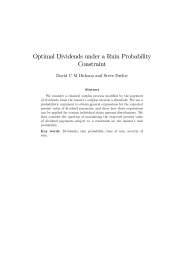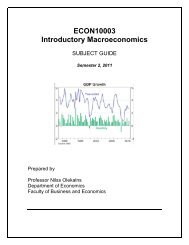Bayesian Inference in the Seemingly Unrelated Regressions Model
Bayesian Inference in the Seemingly Unrelated Regressions Model
Bayesian Inference in the Seemingly Unrelated Regressions Model
Create successful ePaper yourself
Turn your PDF publications into a flip-book with our unique Google optimized e-Paper software.
14<br />
1. Draw<br />
( )<br />
β $<br />
from<br />
( −1)<br />
f( β| Σ $ , y)<br />
.<br />
2. Draw<br />
( )<br />
Σ $<br />
from<br />
( )<br />
f( Σ| β $ , y)<br />
.<br />
Mak<strong>in</strong>g <strong>the</strong>se draws is straightforward, given that <strong>the</strong> two conditional posterior pdf’s<br />
are normal and <strong>in</strong>verted Wishart, respectively. (See <strong>the</strong> appendix for details.) MCMC<br />
<strong>the</strong>ory suggests that, after a sufficiently large number of draws, <strong>the</strong> Markov Cha<strong>in</strong><br />
created by <strong>the</strong> draws will converge. After convergence, <strong>the</strong> subsequent draws can be<br />
viewed as draws from <strong>the</strong> marg<strong>in</strong>al posterior pdf’s f( β | y)<br />
and f( Σ | y)<br />
. It is <strong>the</strong>se<br />
draws that can be used to present results <strong>in</strong> <strong>the</strong> desired fashion. Draws taken prior to<br />
<strong>the</strong> po<strong>in</strong>t at which convergence is assumed to have taken place are sometimes called<br />
<strong>the</strong> "burn <strong>in</strong>"; <strong>the</strong>y are discarded. A large number of diagnostics have been suggested<br />
for assess<strong>in</strong>g whe<strong>the</strong>r convergence has taken place. See, for example, Cowles and<br />
Carl<strong>in</strong> (1996). Assess<strong>in</strong>g whe<strong>the</strong>r convergence has taken place is similar to assess<strong>in</strong>g<br />
whe<strong>the</strong>r a time series is stationary. Thus, visual <strong>in</strong>spection of a graph of <strong>the</strong> sequence<br />
of draws, test<strong>in</strong>g whe<strong>the</strong>r <strong>the</strong> mean and variance are <strong>the</strong> same at <strong>the</strong> beg<strong>in</strong>n<strong>in</strong>g of <strong>the</strong><br />
cha<strong>in</strong> as at <strong>the</strong> end of <strong>the</strong> cha<strong>in</strong>, and test<strong>in</strong>g whe<strong>the</strong>r two or more separately-run cha<strong>in</strong>s<br />
have <strong>the</strong> same mean and variance, are ways of check<strong>in</strong>g for convergence.<br />
S<strong>in</strong>ce we are us<strong>in</strong>g a sample of draws of β and Σ to estimate posterior means<br />
and standard deviations and o<strong>the</strong>r relevant population quantities, <strong>the</strong> accuracy of <strong>the</strong><br />
estimates is a concern. Estimation accuracy is assessed us<strong>in</strong>g numerical standard<br />
errors. Methods for comput<strong>in</strong>g such standard errors are described <strong>in</strong> <strong>the</strong> chapter by<br />
Geweke et al. Because <strong>the</strong> draws produced by MCMC algorithms are correlated, time<br />
series methods are used to compute <strong>the</strong> standard errors; also, larger samples are<br />
required to achieve a given level of accuracy relative to a situation <strong>in</strong>volv<strong>in</strong>g<br />
<strong>in</strong>dependent draws.

















